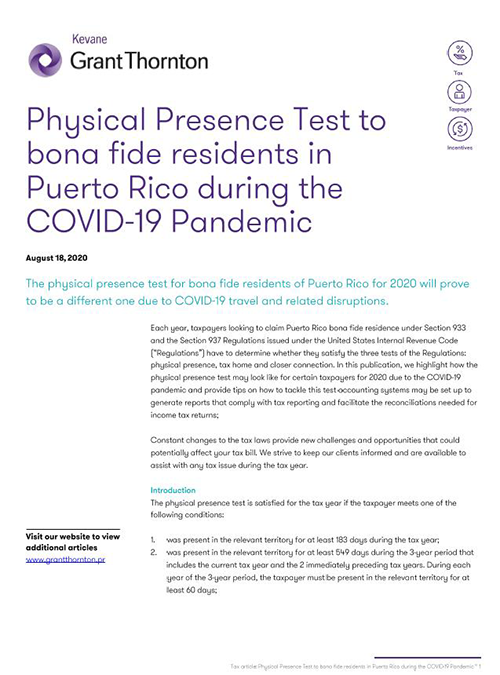-
Financial statements audits
Financial statement audits
-
Compliance audits
Compliance audits
-
Compilations and reviews
Compilations and audit
-
Agreed-upon procedures
Agreed-upon procedures
-
Corporate and business tax
Our trusted teams can prepare corporate tax files and ruling requests, support you with deferrals, accounting procedures and legitimate tax benefits.
-
International tax
Our teams have in-depth knowledge of the relationship between domestic and international tax laws.
-
Tax compliance
Business Tax
-
Individual taxes
Individual taxes
-
Estate and succession planning
Estate and succession planning
-
Global mobility services
Through our global organisation of member firms, we support both companies and individuals, providing insightful solutions to minimise the tax burden for both parties.
-
Sales and use tax and indirect taxes
SUT/ VAT & indirect taxes
-
Tax incentives program
Tax incentives program
-
Transfer Pricing Study
The laws surrounding transfer pricing are becoming ever more complex, as tax affairs of multinational companies are facing scrutiny from media, regulators and the public
-
Business consulting
Our business consulting services can help you improve your operational performance and productivity, adding value throughout your growth life cycle.
-
Forensic and investigative services
At Grant Thornton, we have a wealth of knowledge in forensic services and can support you with issues such as dispute resolution, fraud and insurance claims.
-
Fraud and investigations
The commercial landscape is changing fast. An ever more regulated environment means organizations today must adopt stringent governance and compliance processes. As business has become global, organizations need to adapt to deal with multi-jurisdictional investigations, litigation, and dispute resolution, address the threat of cyber-attack and at the same time protect the organization’s value.
-
Dispute resolutions
Our independent experts are experienced in advising on civil and criminal matters involving contract breaches, partnership disputes, auditor negligence, shareholder disputes and company valuations, disputes for corporates, the public sector and individuals. We act in all forms of dispute resolution, including litigation, arbitration, and mediation.
-
Business risk services
We can help you identify, understand and manage potential risks to safeguard your business and comply with regulatory requirements.
-
Internal audit
We work with our clients to assess their corporate level risk, identify areas of greatest risk and develop appropriate work plans and audit programs to mitigate these risks.
-
Service organization reports
As a service organization, you know how important it is to produce a report for your customers and their auditors that instills confidence and enhances their trust in your services. Grant Thornton Advisory professionals can help you determine which report(s) will satisfy your customers’ needs and provide relevant information to your customers and customers’ auditors that will be a business benefit to you.
-
Transaction advisory services
Transactions are significant events in the life of a business – a successful deal that can have a lasting impact on the future shape of the organizations involved. Because the stakes are high for both buyers and sellers, experience, determination and pragmatism are required to bring deals safely through to conclusion.
-
Mergers and acquisitions
Globalization and company growth ambitions are driving an increase in M&A activity worldwide as businesses look to establish a footprint in countries beyond their own. Even within their own regions, many businesses feel the pressure to acquire in order to establish a strategic presence in new markets, such as those being created by rapid technological innovation.
-
Valuations
We can support you throughout the transaction process – helping achieve the best possible outcome at the point of the transaction and in the longer term.
-
Recovery and reorganization
We provide a wide range of services to recovery and reorganisation professionals, companies and their stakeholders.
The physical presence test for bona fide residents of Puerto Rico for 2020 will prove to be a different one due to COVID-19 travel and related disruptions.
Each year, taxpayers looking to claim Puerto Rico bona fide residence under Section 933 and the Section 937 Regulations issued under the United States Internal Revenue Code (“Regulations”) have to determine whether they satisfy the three tests of the Regulations: physical presence, tax home and closer connection. In this publication, we highlight how the physical presence test may look like for certain taxpayers for 2020 due to the COVID-19 pandemic and provide tips on how to tackle this test accounting systems may be set up to generate reports that comply with tax reporting and facilitate the reconciliations needed for income tax returns;
Constant changes to the tax laws provide new challenges and opportunities that could potentially affect your tax bill. We strive to keep our clients informed and are available to assist with any tax issue during the tax year.
Introduction
The physical presence test is satisfied for the tax year if the taxpayer meets one of the following conditions:
- was present in the relevant territory for at least 183 days during the tax year;
- was present in the relevant territory for at least 549 days during the 3-year period that includes the current tax year and the 2 immediately preceding tax years. During each year of the 3-year period, the taxpayer must be present in the relevant territory for at least 60 day
- was present in the United States for no more than 90 days during the tax year;
- had earned income in the United States of no more than a total of $3,000 and was present for more days in the relevant territory than in the United States during the tax year; or
- had no significant connection to the United States during the tax year.
For purposes of this publication, we will focus on condition number 1, which requires physical presence of at least 183 days within the possession during the tax year in question. Generally, an individual is treated as being present in a relevant possession on any day that he or she is physically present in that location at any time during the day.
IRS Publication No. 570 provides certain exceptions to the “physically present” requirement in cases where the individual is outside of the relevant possession:
- on business or personal travel for up to 30 days;
- to receive, or to accompany a qualified family member to receive, qualifying medical treatment;
- or has left or is unable to return to the relevant possession during 14-day period within which a major disaster occurs in the relevant possession for which a Federal Emergency Management Agency’s (“FEMA”) notice of a federal declaration of a major disaster is issued in the Federal Register, or any period for which a mandatory evacuation order is in effect for the geographic area in the relevant possession in which your main home is located (“Major Disaster”).
On March 27, 2020, FEMA published Notice DR-4493-PR in the Disaster Federal Register establishing a major disaster for Puerto Rico. As a result of the foregoing declaration of a Major Disaster, the 14-day period during which any individual is outside of Puerto Rico during the pandemic beginning on January 20, 2020 will be counted as days within Puerto Rico for purposes of the physical presence test.
As opposed to IRS Notice No. 2017-56, which provided relief for the physical presence test for a 117-day period beginning on September 6, 2017, and ending on December 31, 2017 for Hurricanes Irma and María, the IRS has not provided any additional relief for complying with the physical presence test during the global pandemic.
Practical scenarios
Based on the foregoing, we present the following scenarios assuming there was one Major Disaster during the taxable year and the year of move rules are not applicable:
- the first column sets forth scenarios for a Taxpayer that should not face great challenges in complying with the physical presence test for 2020 as a result of the COVID-19 pandemic
- the second column sets forth scenarios for a Taxpayer that require closer evaluation and assessment of the taxpayer’s residence for 2020 in light of the physical presence test
|
Taxpayer quarantined in Puerto Rico during 2020 and was physically present in Puerto Rico for at least 183 days |
Taxpayer travelled outside Puerto Rico and the United States during 2020 and was not physically present in Puerto Rico for at least 183 days KGT Tip 1: Taxpayer should evaluate whether he or she complies with the rest of the physical presence test alternatives provided in the Regulations (for example, the Taxpayer was outside of Puerto Rico and the United States for 30 days; the 14-day rule for Major Disasters; the Qualifying Medical Treatment exception) |
|
Taxpayer travelled outside of Puerto Rico and the United States for a period longer than 14 days but otherwise was physically present in Puerto Rico for at least 183 days
|
Taxpayer was outside Puerto Rico during 2020, was not physically present in Puerto Rico for at least 183 days within the rules set forth in the Regulations, and does not satisfy other physical presence test alternatives KGT Tip 2: Taxpayer should plan for a 2020 taxable year without the Puerto Rico bona fide residency exception for federal income tax purposes. Taxpayer should also plan for tax implications in Puerto Rico and any relevant country, if outside the United States. Additional tax implications will depend on the tax rules where the taxpayer was located. If the taxpayer has an Act 22 tax exemption grant, he or she should understand the implications of the change in tax residence and required compliance obligations under said grant. |
In all scenarios, the taxpayer should maintain proper documentation to support his/her status. The foregoing discussion includes general considerations for Puerto Rico and United States federal tax purposes in connection to the physical presence test. We do not intend to discuss tax implications at State or local level, or implications in other countries. Also, taxpayers should consider compliance with the tax home and closer connection tests for every taxable year as well.


